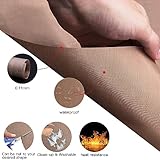 Advertising Disclosure
Advertising DisclosureHeat Transfer Paper Comparison - September 2025

Our Top 3 Picks
Here are the top 3 recommended products with more information to help you find the right product for you9.7
1YRYM HT12% Off3 Pack PTFE Teflon Sheet for Heat Press Transfer Sheet Non Stick 16 x 20" Heat Transfer Paper Reusable Heat Resistant Craft Mat
9.9 Simple to use9.8 worth the money9.8 lasts a long timeWhy we love it
Handles high temperatures effectively.
Versatile for multiple craft uses.
Durable and tear-resistant material.
9.6
2HTVRONTHTVRONT Heat Transfer Paper for T Shirts 20 Sheets, 8.5" X 11" Printable Heat Transfer Vinyl, Vivid Color & Durable Iron on Transfer Paper for Dark Fabric
9.1 Simple to use8.9 Print Quality8.6 worth the moneyWhy we love it
Vibrant colors for standout designs.
Easy application with home iron.
Durable through multiple washes.
9.5
3Printers JackPrinters Jack Iron-On Heat Transfer Paper for Dark Fabric 20 Sheet 8.3x11.7" T-Shirt Transfer Paper for Inkjet Printer Wash Durable, Long Lasting Transfer, No Cracking
8.6 Simple to use8.4 Attachment8.1 worth the moneyWhy we love it
Durable and stretchable material.
Easy to use with clear instructions.
Compatible with popular inkjet printers.

Heat Transfer Paper Buyer's Guide
 Written by Shon Rick
Written by Shon RickIntroduction
Heat transfer paper is a versatile material used in creating custom designs and artwork on fabric. It is commonly used in the textile industry for creating t-shirt designs and other garments. Heat transfer paper is available in a variety of types, each designed for specific applications and materials. The right type of paper should be chosen to ensure the best results and to avoid any damage to the fabric or the design.
Types of Heat Transfer Paper
The most common types of heat transfer paper include sublimation paper, iron-on transfer paper, and printable heat transfer paper. Sublimation paper is specially designed for use with a sublimation printer, which utilizes dye-sublimation inks to transfer designs onto fabric. Iron-on transfer paper is used to create designs on cotton, linen, and other natural fabrics. Printable heat transfer paper is used to create designs on synthetic fabrics and is compatible with most standard inkjet and laser printers.
Compatibility
When selecting a type of heat transfer paper, it is important to consider the compatibility of the paper with the fabric and the printer. Sublimation paper should only be used with sublimation printers and is not suitable for other types of printers. Iron-on transfer paper is designed for use with natural fabrics, while printable heat transfer paper should be used with synthetic fabrics. Additionally, it is important to note that some types of paper are not suitable for use with certain fabrics, such as leather or velvet.

Quality
The quality of the paper also plays an important role in achieving the best results. High-quality heat transfer paper is designed to provide better printing results and longer-lasting designs. Additionally, it is important to select a paper that is suitable for the type of fabric and the type of printer being used. It is recommended to look for papers that are specifically designed for the type of fabric and printer being used.
Durability
Durability is also an important factor when selecting a type of heat transfer paper. High-quality paper is designed to last longer, making it a more cost-effective option. Additionally, some types of paper are designed to be more resistant to fading, which can help ensure that the design will remain vibrant for a longer period of time.
Cost
The cost of the heat transfer paper should also be considered. Different types of paper can vary in price, so it is important to compare prices before making a purchase. Additionally, some types of paper may require additional supplies or equipment, such as a heat press machine, so the overall cost should be taken into account when making a decision.

Our ranking system
At BestChoice.com, our team curates a selection of top products from a vast array available online, using a sophisticated ranking system based on carefully defined criteria.While traditional hands-on testing has its merits, our use of AI technology offers distinct advantages. AI allows us to process and analyze vast amounts of data from multiple sources, providing a comprehensive view that goes beyond what manual testing can achieve. This approach enables us to deliver insights that are aligned with current trends and consumer preferences, ensuring our reviews are both relevant and up-to-date.
Features
Our AI-driven analysis examines key attributes, capabilities, and other critical factors tailored to each product category. This method allows us to assess effectiveness from various perspectives, ensuring a well-rounded evaluation.
Consumer Reviews
We aggregate and evaluate consumer feedback from across the internet, giving weight to ratings and reviews that reflect the most reliable insights. AI enhances this process by filtering and prioritizing data, offering a balanced view without the need for direct personal endorsements.
Popularity
Our system also considers the popularity of products, analyzing factors such as market presence, reputation, and user satisfaction. By leveraging AI, we capture a comprehensive picture of a product's standing in the market, which may not always be evident through traditional testing.
Value for money
AI allows us to compare products based on attributes like price, specifications, and user feedback, helping to determine their value for money. This data-driven approach offers an efficient and reliable way to assess how products stack up against one another in terms of cost-effectiveness.




























